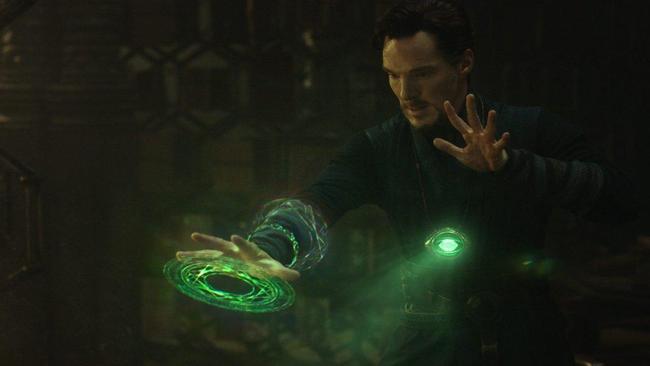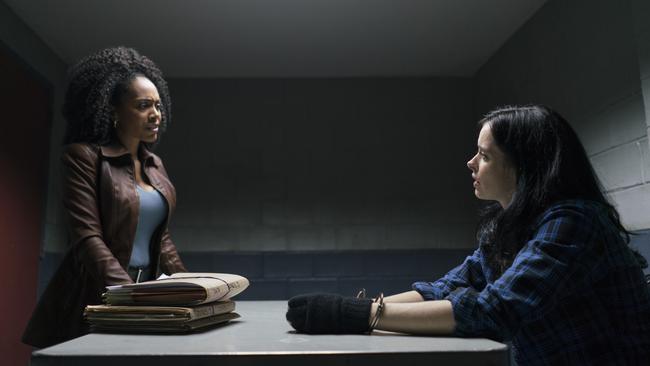The Marvel Cinematic Universe explained
THERE have been 15 movies (with nine to come) and six TV shows (with four more on their way) in the confusing Marvel universe. Here’s how it all works.
New Movies
Don't miss out on the headlines from New Movies. Followed categories will be added to My News.
WITH the release of Guardians of the Galaxy Vol. 2 tomorrow, now seems like as good a time as any for a refresher course on the ever-expanding world of the Marvel Cinematic Universe (MCU).
If you’re finding it hard to keep track of the gargantuan franchise Marvel has thrust upon us, who can blame you?
As of this month, there have been 15 movies released (including Guardians 2), nine more films officially in the works, six TV shows that have aired and another four coming. It’s a lot.
While the announced projects only go as far as 2019, Marvel Studios boss Kevin Feige has story plans stretching to 2028. That’s right. 2028. Let that sink in for a moment. Think of how old you’ll be in 2028.
Marvel has been at it for a while now, since it released Iron Man in 2008, and audiences have had almost a decade to familiarise themselves with the idea of a shared screen universe in which all these characters, films and TV shows exist in the same fictional reality. What happens in one movie could have ramifications in another — everything (EVERYTHING!) is connected.
Even the movies and TV shows that aren’t significantly connected (yet) have a raft of “easter eggs” for fans to spot.
If you’re looking for a more comprehensive backgrounder on who’s who in the MCU, exactly how the first six years fit together and why there aren’t any mutants (X-Men) in the MCU, check out this explainer we did around the time of Avengers: The Age of Ultron’s release — it’ll help if you’re missing some of the backstory.
Here, we’ll take a look at the state of play in the MCU and what’s coming in the next three years.
THE MOVIE WORLD
With the origin stories of the main Avengers — Iron Man, Thor, Captain America, Hulk — already behind us, Marvel is moving to introduce the next round of superheroes, all the more important as the more established actors have already been involved in the franchise for years and there aren’t that many films left on their contracts.
Most of the newbie heroes we’ve already met in Captain America: Civil War (e.g. Black Panther and Spider-Man) and they will both get to headline their own movies soon. Marvel also tapped Oscar winner Brie Larson to don Captain Marvel’s costume for her own film, which will be the first female-led MCU film to be co-helmed by the franchise’s first female director. Captain Marvel is the alter ego of Carol Danvers and in the comics, she can fly, is crazy strong and can absorb energy.
But before we sideline the original Avengers too much, there is a third Thor outing on its way directed by Kiwi Taika Waititi (Hunt For The Wilderpeople, Boy, What We Do in the Shadows). The trailer was released a couple of weeks ago and already hints at the renewed energy after a narratively lacklustre Thor: The Dark World.
Avengers old and new are also expected to cram into an upcoming Avengers: Infinity War and an as yet untitled fourth Avengers flick.
Upcoming MCU films:
• Spider-Man: Homecoming — July 2017
• Thor: Ragnarok — November 2017
• Black Panther — February 2018
• Avengers: Infinity War — May 2018
• Ant-Man and the Wasp — July 2018
• Captain Marvel — March 2019
• Untitled Avengers film — May 2019
• Spider-Man: Homecoming 2 — July 2019
• Guardians of the Galaxy Vol. 3 — TBA
INFINITY STONES
At this point, we would implore you to remember that this is a comic-book movie franchise if it’s starting to sound a bit silly, so this is what you signed up for.
When we’re all flocking to Avengers: Infinity War in a year’s time, it’s important to know that Marvel has been scattering various infinity stones throughout its whole film franchise.
Some of the stones appeared in the earlier films but they weren’t identified as such we didn’t know what the infinity stones were until the first Guardians movie. Since then, the infinity stones have formed the wider arc of the MCU films, connecting all of the films into one overarching story. It’s the MacGuffins of this universe.
The infinity stones are six stones of immense power which originated as six singularities. Each represent an aspect of the universe — space, mind, reality, power, time and soul.
So far, we’ve met five of the six stones.
• The blue space stone is housed within the Tesseract that was vital to the first Captain America and Avengers films and is currently in the keep of Heimdall (Idris Elba) on Asgard.
• The reality stone manifested as the Aether, the mystical red energy that possessed Jane Foster (Natalie Portman) in Thor: The Dark World — it’s currently in the possession of The Collector (Benicio Del Toro).
• The mind stone was originally housed in Loki’s (Tom Hiddleston) sceptre but was used to give life to Vision (Paul Bettany) and is currently sitting smack bang in the middle of his wise forehead.
• The power stone was introduced in the first Guardians of the Galaxy movie, hidden inside a potentially world-destroying orb. It’s currently under lock and key of the Nova Corps.
• The time stone is set in a rather gauche pendant known as the Eye of Agamotto belonging to the Masters of Mystical Arts. We last saw Doctor Strange (Benedict Cumberbatch) returning it to the library in Kamar-Taj.

The idea is that if you combine the six stones, it will imbue the owner with untold, godlike powers, which is why they’ve been kept apart. Unfortunately for our heroes (and the world), someone is trying to assemble them all for his own nefarious purposes — purple-tinted villain Thanos (Josh Brolin).
Thanos has manipulated several events in the MCU movies to put the infinity stones in play — something Thor guessed as much in Avengers: Age of Ultron, if not who — and all the MCU films are leading to a mighty showdown in Avengers: Infinity War
Of course, the elusive sixth stone, the soul stone, will have to surface in either Spider-Man: Homecoming or, more likely, Thor: Ragnarok for it to all come together.
THE TV WORLD
While still a part of the MCU, the TV shows aren’t as connected to the film franchises as they once were.
Agents of SHIELD was previously in lock-step with the movies, especially in its first season when it had a Rosencrantz and Guildenstern-esque episode that took place simultaneously with the events of Captain America: Winter Soldier. There are still passing references to film plot points like the Sokovia Accords but it’s been largely functioning in its own world in the past couple of seasons.
One element introduced in SHIELD that was originally intended to spin off into the films was the Inhumans, a kind of human-alien hybrid race. But now the Inhumans movie has been struck off the film schedule and will instead become a TV show that’s set to premiere in the US in September this year. The show has already started filming and among its cast is Iwan Rheon (best known as Ramsay Bolton from Game of Thrones) and Australian actor Isabelle Cornish.
There’s also a series called Cloak & Dagger about two teenagers who realise their powers work better when they’re together. The 10-episode series is expected to air in 2018.

Perhaps the best known TV of the MCU is the collection on Netflix. We’ve already had two seasons of Daredevil, one of Jessica Jones with season two currently filming, one of Luke Cage with season two in development and one of Iron Fist.
The four superheroes of the Netflix oeuvre will come together in an eight-episode miniseries, The Defenders, in August this year when they form a merry band to take down a threat in New York City.
There’s also a Daredevil spin-off, The Punisher, which just wrapped up filming and is looking at a late 2017 release on the streaming juggernaut.
The Netflix side of the Marvel TV world haven’t had any character or plot crossovers with the movies but there have been enough references to confirm it is part of the same universe.
Like I said, everything is connected.
Guardians of the Galaxy Vol. 2 will be in cinemas from Tuesday, April 25.
Continue the conversation on Twitter with @wenleima.
Originally published as The Marvel Cinematic Universe explained


